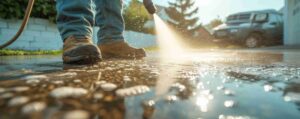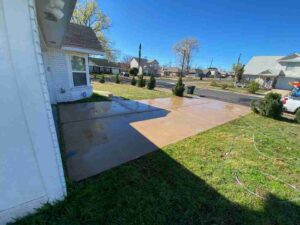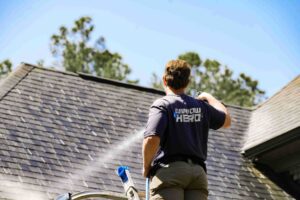Instant Home Upgrades: Power Washing Siding
Is your house exterior starting to look a little dingy? If so, it’s no fault of your own.
The exterior of your home is exposed and subjected to a wide variety of weather and other natural elements that can build up over time. As rain, dirt, and even algae begin to accumulate on the side of your home, it can quickly become unsightly and even decrease the home value.
All you need to do to make your house shine like new again is to give the siding a good cleaning. But that’s a lot of surface area to cover, and your time is valuable.
Considering this, power washing siding might be the quickest and most effective way to clean the gunk that’s making your home look older than it actually is.
In this post, we’ll review how power washing siding is one of the most effective ways to clean the exterior of your home.
High-Pressure Washing vs. Power Washing
First, however, a distinction must be made between high-pressure washing and power washing.
Water is a powerful element. With enough time and force, it can carve out canyons. And when you’re pressure washing siding, the water can quickly make dents, tears, and strip paint.
This damage isn’t only reserved for the surface of the siding, though. If one isn’t careful, the water jets could reach beneath the siding and actually create holes and leaks in the side of the house. Remember, the goal of power washing siding is to make less work for yourself.
Using a high-pressure washer to clean house siding is NEVER advised. Using high water pressure can quickly result in extensive damage to the siding. As such, it’s highly recommended that a power washer is used at low pressure. Using a power washer at low pressure will clean the exterior effectively and won’t result in damage.
Power Washing Siding Tips
Power washing siding is an extremely effective way to clean large surface areas such as the exterior of a house. But even without high water pressure, care must be taken to ensure that the cleaning process doesn’t damage your home’s exterior.
To get started on power washing siding on your own home, check out the tips listed below. It’s not a complicated process, and in the end, you’ll be grateful you didn’t opt for scrubbing the exterior by hand.
Avoiding Damage
As previously discussed, your home’s exterior should be cleaned using a power washer set to a low pressure. Under no circumstances should a high-pressure washer be used.
Using a power washer ensures that only grime is removed from the siding. Also, high-pressure washers are only suitable for certain types of siding such as vinyl, steel, and aluminum. However, the pressure can quickly remove paint, cause dents, and even crack the material.
Power washers, alternatively, can be used safely on all types of siding materials. Because the washer operates at a low pressure, materials such as stucco, brick, and wood can be cleaned safely. Using high pressure on these materials can force water through the material and into the interior walls.
Use the Correct Nozzle
Before you begin power washing, you’ll need to select the right nozzle for the job. Most power washers come with a variety of tips and nozzles. Some are better suited for power washing siding than others.
To ensure that the water stream is uniform, consider using a nozzle tip that shoots water out at about fifteen degrees. This will give the water consistency as it sprays against the side and will help streamline the cleaning process.
Safety First
Using a power washer does require some basic safety measures. First, eye protection such as goggles should be worn. A power washer uses extremely high pressures and if you aren’t careful, this could be very damaging to the delicate structure of your eye.
Even if you don’t plan on looking down the barrel of the pressure washer, there is still a chance that a high-pressure water stream can bounce back from the cleaning surface and hit you in the eye.
It’s also a prudent idea to wear protective gloves. Power washers also use water at high temperatures which can quickly burn exposed skin.
Working From the Top Down
When pressure washing the exterior, make sure you never spray upward. Doing so can work water beneath the siding and create cracks which allow the water to seep in through the exterior.
To prevent this from happening, it’s important to work from the top down. Use a stable ladder to elevate yourself above the area that needs cleaning.
Also, make sure that the nozzle isn’t too close to the siding. Otherwise, you risk chipping the paint and causing other damage.
Working from the top down will also ensure that what you’ve already cleaned stays clean as the dirty water will run down the side instead of getting pushed upward.
Cleaning Up
Using a power washer to clean the exterior of your home is a good way to make quick work of an otherwise big job. While it is effective, there are risks involved. To avoid causing damage to the exterior of your home, remember to use:
*The correct nozzle
*Eye and hand protection
*Extra precaution for brick, stucco, and wood
Additionally, remember to not spray too close to the surface and work from the top down. Not causing any damage is easy, all it takes is a bit of patience, concentration, and most importantly, low water pressure.
Your Next Step: Hire a Pro!
Now that the exterior of your home is nice and clean again, you can finally move on to other projects, like cleaning gutters!
However, if you don’t have the time or the patience for power washing siding, we understand. Labor Panes only uses power washers set at low pressures. This is combined with a special soap solution that gently lifts the grime from the siding before it’s rinsed away.
To learn more about Labor Panes’ professional exterior cleaning services, find a location near you and we’ll do the rest!


